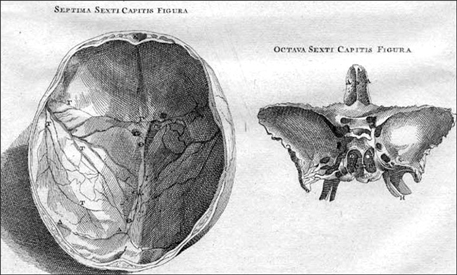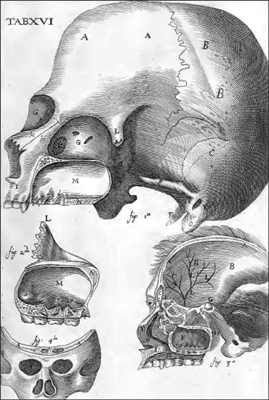Anat Cell Biol.
2013 Dec;46(4):235-238. 10.5115/acb.2013.46.4.235.
Evolution of the paranasal sinuses' anatomy through the ages
- Affiliations
-
- 1Department of Anatomy, Medical Faculty, Aristotle University of Thessaloniki, Thessaloniki, Greece. g_paraskevas@yahoo.gr
- KMID: 2046763
- DOI: http://doi.org/10.5115/acb.2013.46.4.235
Abstract
- Previously, anatomists considered paranasal sinuses as a mysterious region of the human skull. Historically, paranasal sinuses were first identified by ancient Egyptians and later, by Greek physicians. After a long period of no remarkable improvement in the understanding of anatomy during the Middle Ages, anatomists of the Renaissance period-Leonardo da Vinci and Vesalius-made their own contribution. Nathaniel Highmore's name is also associated with the anatomy of paranasal sinuses as he was first to describe the maxillary sinus.
Keyword
Figure
Reference
-
1. Nall GH. Macmillan's elementary Latin-English dictionary. London: Macmillan and Co. Ltd;1964.2. Gazi A. Dictionary of the Greek language. Athens: Mati;1839.3. Formby ML. The maxillary sinus. Proc R Soc Med. 1960; 53:163–168.4. Lascaratos JG, Segas JV, Trompoukis CC, Assimakopoulos DA. From the roots of rhinology: the reconstruction of nasal injuries by Hippocrates. Ann Otol Rhinol Laryngol. 2003; 112:159–162.5. Tange RA. Some historical aspects of the surgical treatment of the infected maxillary sinus. Rhinology. 1991; 29:155–162.6. Leopold D. A history of rhinology in North America. Otolaryngol Head Neck Surg. 1996; 115:283–297.7. Hippocrates . Collected writings. Athens: Cactus;1992. Vol. 4.8. Kaluskar SK. Evolution of rhinology. Indian J Otolaryngol Head Neck Surg. 2008; 60:101–105.9. Nogueira JF Jr, Hermann DR, Américo Rdos R, Barauna Filho IS, Stamm AE, Pignatari SS. A brief history of otorhinolaryngolgy: otology, laryngology and rhinology. Braz J Otorhinolaryngol. 2007; 73:693–703.10. Tsoucalas G, Gentimi F, Kousoulis AA, Karamanou M, Androutsos G. Joseph Gensoul and the earliest illustrated operations for maxillary sinus carcinoma. Eur Arch Otorhinolaryngol. 2013; 270:359–362.11. The drawings of Leonardo da Vinci [Internet]. cited 2013 Dec 23. Available from: http://www.drawingsofleonardo.org/.12. Jose AM. Anatomy and Leonardo da Vinci. Yale J Biol Med. 2001; 74:185–195.13. Feldmann H. The maxillary sinus and its illness in the history of rhinology. Images from the history of otorhinolaryngology, highlighted by instruments from the collection of the German Medical History Museum in Ingolstadt. Laryngorhinootologie. 1998; 77:587–595.14. Garrison D, Hast M. On the fabric of the human body: an annotated translation of the 1543 and 1555 editions of Andreas Vesalius' De Humani Corporis Fabrica [Internet]. Illinois: Northwestern University;2003. cited 2013 Apr 28. Available from: http://vesalius.northwestern.edu/flash.html.15. Garrison DH, Hast MH. Andreas Vesalius on the larynx and hyoid bone: an annotated translation from the 1543 and 1555 editions of De humani corporis fabrica. Med Hist. 1993; 37:3–36.16. Wells WA. Nathaniel Highmore, seventeenth century pioneer in anatomy and embryology. Laryngoscope. 1948; 58:583–597.17. Stephen L, Lee S. Dictionary of national biography. New York: Macmillan and Co;1891. Vol. 26.18. Prideaux de C. A note on Nathaniel Highmore, M.D. [1613-1685], and his memorial tablet in Purse Caundle Church, Dorset. Proc R Soc Med. 1914; 7:106–8.19. Highmore N. Corporis humani disquisitio anatomica. The Hague: Samuel Brown;1651.20. Mosher HP. The anatomy of the sphenoidal sinus and the method of approaching it from the antrum. Laryngoscope. 1903; 13:177–214.
- Full Text Links
- Actions
-
Cited
- CITED
-
- Close
- Share
- Similar articles
-
- The Differences in Paranasal Sinus Pneumatization after Adolescence in Korean
- A Morphological Study of the Paranasal Sinuses in Koreans
- Massive Osteoma of the Paranasal Sinuses
- Two Cases of Fungus Ball in Bilateral Paranasal Sinuses
- Aspergillosis of the paranasal sinuses: diagnostic significance of the computed tomography




